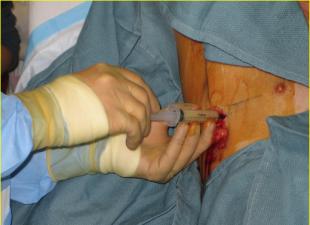Valentina Dmitrievna Schmidt
Lesson on visual activity in the middle group. Breakaway application "Live Clouds"
LESSON ON ART ACTIVITIES.
SUBJECT:» APPLIQUE BREAKING. « LIVING CLOUDS» .
GOAL: TO EXPAND THE CONCEPT OF THE SKY AND ITS IMPACT ON THE LIFE OF OUR PLANET; DEVELOP THE PERCEPTION OF THE BEAUTY AND DIVERSITY OF THE HEAVENLY SPHERE.
TASKS. TEACH CHILDREN PICTURE CLOUDS, SIMILAR IN THE FORM TO Familiar OBJECTS OR PHENOMENA. CONTINUE DEVELOPMENT BREAKING TECHNIQUE APPLICATIONS. DEVELOP IMAGINATION, ATTENTION AND OBSERVATION. COORDINATE THE MOVEMENT OF EYES AND HANDS. TO EDUCATE INTEREST IN KNOWLEDGE OF NATURE, A SENSE OF HUMOR.
PRELIMINARY WORK. OBSERVATIONS FOR CLOUDS DURING WALKS AND EXCURSIONS. DIDACTIC GAME "WHAT ARE THE CLOUDS?»
CONVERSATION. Run across the sky different little animals:
Bears, wolves, hares, foxes, pigs.
And if you are rich in fantasy,
Find your portrait there, guys.
Mystery. They fly without wings, they run without legs,
Sailing without a sail. (Clouds.)
Invite the children to look at the sky, what do you see? What are today clouds? What are today's clouds?
Weaved from lace
Birds_clouds.
Maybe it's a fairy tale
Rushing through the ages?
Research activity. To find cloud similar to an object of living, inanimate nature. To find clouds horse-like. Compare Pinnate clouds and cumulus.
Finger gymnastics "High in the sky". « Clouds» .
Materials, tools, equipment. Sheets of paper in blue or bright blue for the background, sheets of white paper for cloud images, glue, brushes, paper napkins. Reproductions of paintings by I. Aivazovsky, F. Vasiliev, I. Shishkin. Photos, art cards, calendars, magazine illustrations with clouds. Poster "Sky"
Course progress.
The teacher shows the children clouds on reproductions of paintings by landscape painters (I. K. Aivazovsky, F. A. Vasiliev, I. I. Shishkin, magazine illustrations, posters, photographs and conducts, but a meaningful conversation about the sky and clouds. Clarifies the idea of what clouds carry water; in the warm season - in the form of rain, and in the cold season - in the form of snow or hail. Tells that clouds have different outlines. Scientists distinguish between species such as cumulus, pinnate and stratus clouds. Cumulus look like heaps of cotton wool, pinnate look like feathers, and stratus look like puff pastry confectionery. Artists and poets like to compare clouds with different animals, plants, buildings, fabulous creatures (The teacher refers to the experience of children gained while observing clouds). Each cloud unique in its outlines, besides clouds change all the time, may even "melt". And another interesting feature - if on the same cloud different people will look, they will see it differently differently: one will remember the camel, the second - the mountains, the third - the forest.
The teacher invites the children to listen to a comic poem by V. Shipunova « cloud caught» .
The teacher takes a sheet of white paper, quickly cuts it off in the form of a cloud,
In this and several subsequent lessons, we will teach the child to work with torn paper.
We will need:
Flour or starch paste, glue stick, PVA glue.
Multi-colored paper of various degrees of density. It is better to use double-sided colored paper so that the kids do not confuse which side of the figure should be glued.
Thick white paper, colored cardboard.
Foam rubber sponges, brushes, napkins, oilcloth, etc.
Toys (for playing the plot).
Application methods:
Paper tearing.
Paper tearing - tearing off pieces of paper along the contour to get a figure with jagged edges.
Target:To teach children to carefully tear paper into pieces of different sizes and shapes, to glue pieces of paper to cardboard; generate interest and a positive attitude towards the application.
Material:Thin white paper; cardboard A4 blue or blue; flour or starch paste.
Application methods. Tearing paper into pieces; spreading glue with fingers; sticking.
Lesson progress
- Let's look with you through the window at the sky. Look at the sky, what color is it?
- That's right, blue.
- Clouds float across the sky. What color are the clouds?
- Correct white clouds.
- Let's look at the clouds and think about what they are, how you can say about them.
- The clouds are fluffy, large and small, airy. They are all different shapes.
- Let's make paper clouds with you.
Clouds,
Clouds -
curly sides,
Curly clouds,
whole,
holey,
Lungs,
Air -
Obedient to the wind...
I'm lying in the meadow
From the grass I look at you ... (S. Mikhalkov)
The sun shines in the blue sky
And there are clouds in the sky
Like pillows and feather beds -
It's soft there for sure!
I dream - if I
Accelerate and fly
Directly to them - there, to the sky -
I could see the ground!
Cities, seas and countries,
As on my globe!..
What are you sitting? Mom asked,
We are walking with you.
The sun is bright in the window -
The clouds float.
I wave my hand after them -
Goodbye! Bye!.. (O. Emelyanova)
You can guess the riddle:
Fluffy cotton
Float somewhere.
The cotton is lower
The closer the rain is.
(Clouds)
Give your child a piece of white paper and ask them to make clouds. Show how to hold the paper with your thumbs and forefingers (you can also help with middle fingers), how to tear it in the right direction with gentle movements to get pieces of the required shape and size. If the child does not succeed, help him. There can be one cloud, and if the baby likes it, there can be many.
When the clouds are ready, give the child blue or blue cardboard, explain that this will be the sky. And clouds float across the sky.
Show the child how to apply glue to the resulting pieces of paper (smear the glue with your finger from the center to the edges in an even layer), how to apply them with the glued side to the cardboard, press the image with your palm and smooth it with a napkin or cloth.
While the child will stick the clouds, you can turn on the song "Clouds white-maned horses."
_________________________________________
The following book was used in preparing the lesson:
E.A. Yanushko. Application with young children (1-3 years). Methodological guide for educators and parents. - M.: Mosaic synthesis, 2006 - 64 pages.
Target:Formation of interest in the aesthetic side of the surrounding reality, aesthetic attitude to objects and phenomena of the surrounding world. Development children's artistic creativity, interest in independent creative activity, satisfaction of children's needs for self-expression. Development interest in various types of visual activity; improving skills in the application.
Region Integration:
“Artistic and aesthetic development” (priority, “Cognitive development”, “Speech development”, “Social and communicative”.
Integrated tasks:
Educational:
To form children's ideas about mushrooms (mushrooms are edible and inedible) about their relative size. Strengthen the ability of children to create decorative compositions. In order to create an expressive image, teach the technique of tearing paper with small movements of the fingers. Encourage the creation of subject and plot compositions, supplement them with details that enrich the images
Educational:
To develop an eye, fine motor skills of hands, figuratively logical thinking, spatial imagination, memory, attention.
Educational:
Raising the desire and ability to interact with peers when creating teamwork.
Materials: Models of mushrooms, illustrations with mushrooms, mushroom templates, colored paper napkins, rags, brushes, glue, oilcloths for each child. Basket drawing on F-A1.
Preliminary work: Examining illustrations with mushrooms. Cutting out the mushroom template at the request of the children (boletus, chanterelle, fly agaric) along the contour, coloring the stem of the mushroom. Cutting colored paper napkins (red, white, brown, yellow.) into 4 parts,
1. Organizational part.
(Soothing music sounds, soundtrack "Sounds of the forest")
Educator: Guys guess the riddle:
"Under the pine by the path
Who is standing among the grass?
There is a leg, but no boots.
There is a hat, no head
Children: Mushroom
Educator: Guys, please come closer to the TV. Let's look at photographs of mushrooms and recall some of them.
- Mushrooms grow in the forest from summer to autumn, and they need warmth and moisture to grow. What mushrooms do you know?
Children: (Boletus, chanterelles, boletus, boletus, etc.)
Educator: That's right, what kind of mushrooms are they, call them in one word?
Children: edible.
- How do you like to eat mushrooms?
Children: (Mushroom soup, salted, marinated, fried, etc.)
- Educator: And what other mushrooms grow?
Children: inedible (fly agaric, toadstools).
- Is it possible to collect them. (Not).
2. Practical part.
Educator: Today, guys, we will make a very interesting and unusual application “Mushrooms” (Showing the made template, first decorate the mushroom cap, and then put them in a magic basket, but before we start, let's do the exercises.
Physical education minute
They walked along the path, (Marching)
The boletus was found. (Bent over)
They walked along the path, (Marching)
Borovik found. (Bent over)
Borovik upland
He took cover in the moss with his head, (They showed that his hands were above his head in the "castle",
We could pass it - (Walking in a circle).
It's good that they were quiet. (stopped)
Instruction:
1. We take napkins according to the color of your mushroom cap.
2. Gently tear a small piece of napkin with your fingers.
3. We crush this piece of napkin with our fingers to make a small ball.
4. Let's cook a lot of these balls.
5. Apply glue to the mushroom cap.
6. Then lay the whole hat with napkin balls.
7. Let the product dry - the mushrooms are ready!
3. Independent work of children.
I propose to take your templates (boletus, chanterelle, fly agaric, which you prepared yesterday, and I invite you to sit down at the tables.
The teacher sits next to the children. We start the guys to do the work (explanation, individual help).
4. Final part.
Well done guys, bring your mushrooms to the basket.
Children beautifully arrange them on a sheet with a basket.
Educator: Look guys, what did we get?
Children: Composition.
Teacher: What should we name this song?
Children: "Basket with mushrooms"
Since our basket contains both edible and inedible mushrooms, I propose to give it to the forest toy inhabitants who are in our group. You agree with me?
Lyubov Fedotova
I want to bring to your attention a summary of the cloud observation walk lesson.
The purpose of the lesson - walks:
Learn to see the beauty of the world around;
To form an idea about the phenomena of inanimate nature;
Develop mindfulness, imagination and imagination.
Conduct:
Educator: Today I want to invite you to go to the zoo.
Children: But we don't have a zoo nearby.
Educator: This is an unusual zoo and the animals there are unusual. First guess the riddle and then you will understand everything:
"White sheep,
The field is blue
Looking down into the river
What it is?"
Children: Clouds.
Educator: Correctly. These are clouds and animals will be from the sky-high zoo. And who knows how clouds appear?
Children: Water evaporates and rises to form clouds.
Educator: Correctly. Clouds are water that evaporates from seas and oceans, rivers and lakes, ponds and streams. Light vapor rises high into the sky and gathers into small light clouds. They float across the sky and gather into large large clouds, and turn water vapor into raindrops. Let's remember how steam is formed and raindrops appear (experiment with hot water in a glass closed with a glass lid).
Educator: As the cloud grows, the wind carries it far, far away from where it was born.
"Clouds, clouds -
Curly sides.
Curly clouds,
Whole, perforated,
Light, airy
obedient to the breeze." (S. Mikhalkov)
Let's watch the clouds (children look at the clouds)
Educator: What happens to them?
Children: They float, they change.
Educator: Correctly. I suggest you play the game "Ride on the cloud":
Hoops - clouds are laid out on the grass. Children to the music (“Clouds are white-maned horses”) move around the playground,

after the words:
"Do not look down, please,
And roll us across the sky, clouds ... ”, the music is interrupted, and the children occupy the hoops. Whoever lacks a hoop is out of the game.

Note: So that the game is not long and reaches its logical end - there is one player left, we immediately lay out less hoops than children, and remove 2 - 3 hoops at once.
Educator: And you can also predict the weather by the type of clouds: if the clouds are light, high in the sky, quickly floating across the sky, the weather will be fine; if the clouds are low, dense and almost stationary, expect rain. What do you think the weather will be like in the near future?
Children: In the near future the weather will be fine, without rain.
Educator: Since the weather is good - it's time to go to the zoo - we will notice a cloud in the sky, very similar to an animal, show it to friends and take a picture for memory - everything is like in a real zoo.
Conducted didactic game "What does a cloud look like":
"There are white lumps in the sky -
The dogs, the flowers.
Past us from afar
The clouds are floating."
Children look at the clouds, share their impressions and take pictures of their "animals".
Educator: I propose to draw your animal (drawing with foam rubber - the “sticking” technique). Children draw.

After that, a vernissage of children's work is arranged.


and carried out role-playing game "Exhibition - Zoo", where each child strives to become a guide and talk about his cloud.
I propose to see photos of some "animals".

This is a hare.

Crocodile.


Dragon (turns his head on his back).

Firebird.

The bear peeks out from behind a log.


Above is a capercaillie, and below it is a dinosaur.
On an evening walk, we continued the theme of clouds - we made them from plastic bags

and play games with them. “Do not drop”, “I will draw a cloud through a rainbow - an arc”, Game - relay race “Collect a cloud”.
The breakaway look of the applique is convenient for little kids who are just starting to create their first paper crafts. Such work is considered safe for kids, since they do not have to deal with scissors, they simply tear the sheets into slices.
Consider examples of master classes with step-by-step instructions and stencils that relate to topics.

In the younger group, and in the middle group, it is better to fill in the existing drawing with torn pieces of paper. For example, any coloring with a large image is taken and the required number of copies is made or templates are printed.


Finely tear paper strips. 
We glue them in the form of a mosaic on the prepared drawn figure, leave a distance between the pieces, do not glue them close to each other.  The eyes and nose are cut out by adults or torn just like that, but from paper of a different color.
The eyes and nose are cut out by adults or torn just like that, but from paper of a different color. 
Snowman in clipping technique
The torn technique isn't just about tearing the paper into small pieces. Step by step instructions in the next master class, will help to understand this matter.
Step by step:

Applications of paintings in broken technique
For children in the preparatory group, large works are suitable that are completely lined with torn elements. See what beautiful pictures your children will have:  It is not necessary to tear, you can randomly cut into uneven patches:
It is not necessary to tear, you can randomly cut into uneven patches:  And this is a task for younger students to cut off complex elements:
And this is a task for younger students to cut off complex elements:  An example of work, when there are contours, inside is filled neatly and beautifully:
An example of work, when there are contours, inside is filled neatly and beautifully: 
Breakaway technique from napkins
Multi-colored napkins that are torn to pieces will add airiness and lightness to the application.  Trees also come out wonderfully, the trunk is made at will: cut, drawn or torn:
Trees also come out wonderfully, the trunk is made at will: cut, drawn or torn:  But the most beautiful thing is when you roll torn strips of napkins into arbitrary balls.
But the most beautiful thing is when you roll torn strips of napkins into arbitrary balls.
Breakaway cotton appliqué
Take cotton wool or cotton pads, and let the children tear them into small shreds with their hands, with which they will then lay out their individual picture. Birds, animals, flowers, snow, clouds will look beautiful and gentle.  Step by step lay out and glue pieces of cotton wool on the drawn figures.
Step by step lay out and glue pieces of cotton wool on the drawn figures. 
 And for adult artists, it is proposed to complete a large complex image in its entirety:
And for adult artists, it is proposed to complete a large complex image in its entirety: 

 uptostart.ru News. Games. Instructions. Internet. Office.
uptostart.ru News. Games. Instructions. Internet. Office.


